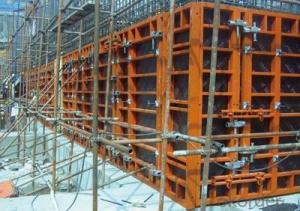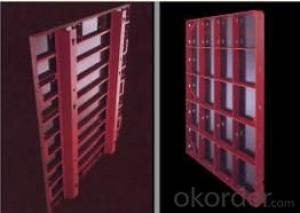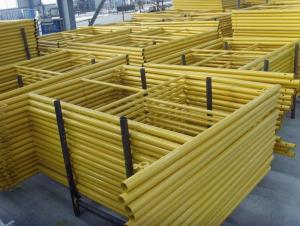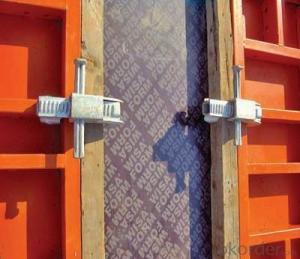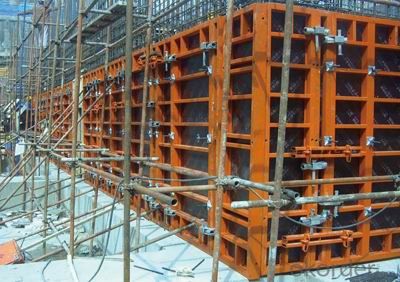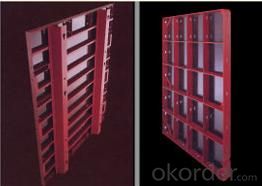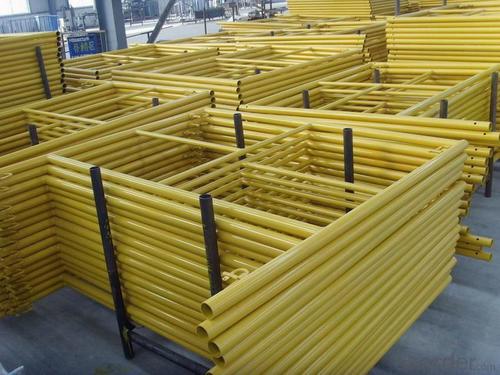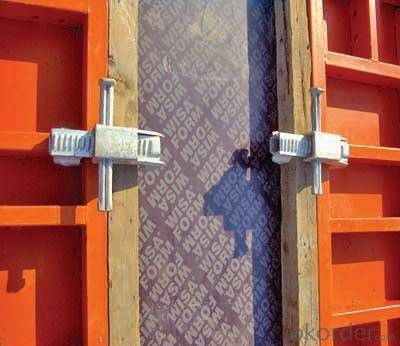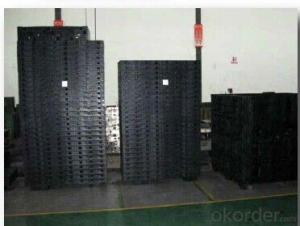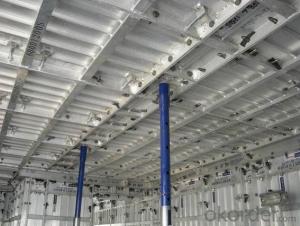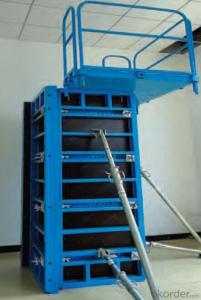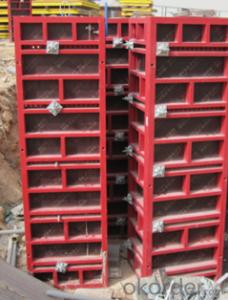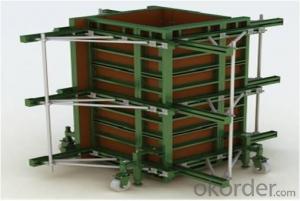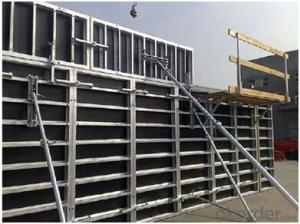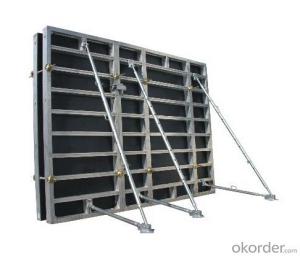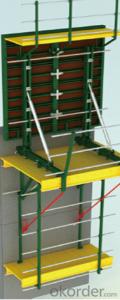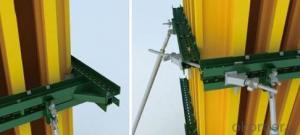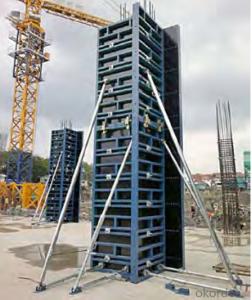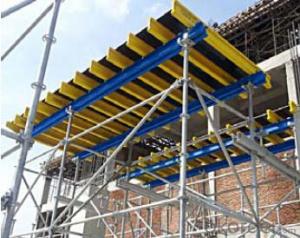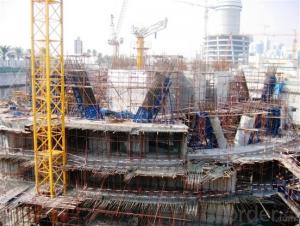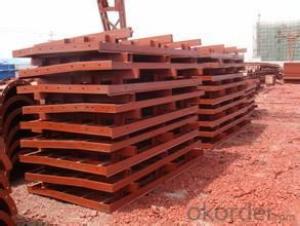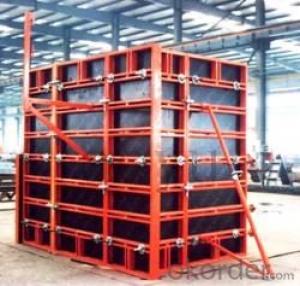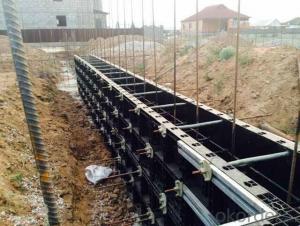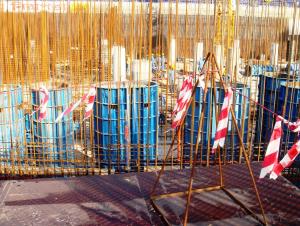Steel Frame Formwork with High Quality and Strong Strength in China
- Loading Port:
- Shanghai
- Payment Terms:
- TT or LC
- Min Order Qty:
- 1 m²
- Supply Capability:
- 100000000 m²/month
OKorder Service Pledge
OKorder Financial Service
You Might Also Like
1. Structure of Steel Frame Formwork GK120
There is a prizing part designed in the corner, which can help to position and remove formwork easily.
The formwork series are a complete system with a full set of accessories, and can be set up flexibly according to project demand.
2. Main Features of Steel Frame Formwork GK120
High strength
High standardized system
Convenient for construction
Easy to control the quality
Easy, rapid and economical.
3. Steel Frame Formwork GK120 Images
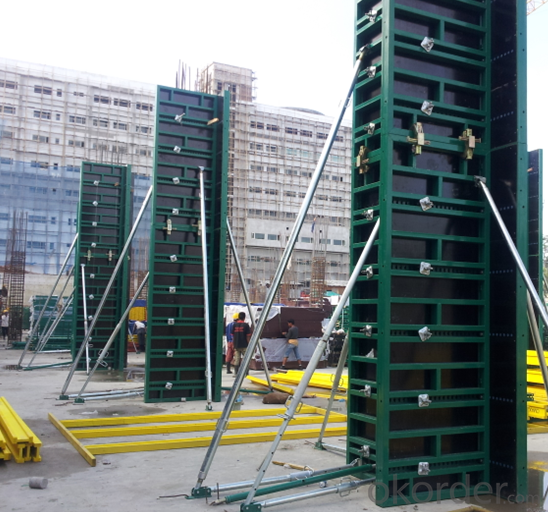
4. Steel Frame Formwork GK120 Specification
-Steel Frame Formwork GK120 is used for the concrete pouring of square or rectangle column. The system has the same structure and similar connection type with wall formwork.
-The frame is highly strengthened, and the wall formwork can bear lateral pressure 60 KN/m2 while the column formwork can bear 80 KN/m2.
-The plywood is screwed on from the back when connecting frame and plywood, so the surface of the finished concrete is perfect.
5. FAQ of Steel Frame Formwork GK120
1) What promises can be done by us?
. If interested in Steel Frame Formwork GK120, please feel free to write us for any QUOTE.
. Please DO check goods when courier knocks your door and contact us asap if any issue.
2) What about of our after-sale service?
. Response will be carried out in 24hours after receiving any complain or request.
. Steel Frame Formwork GK120 cost can be refund after order is confirmed.
3) What about the package and shipping time?
.Packing: As Customer's Requirements
.Shipping: We have various shipping ways for our customers, such as express which including TNT, DHL, FEDEX, UPS, EMS, etc. ; by air/ sea, and we are VIP of these express.
.Shipping time:
Normally small orders, it just 10-15 business days to arrive your hand; When comes to the customs declaration, it may need 7 days.
- Q: How does steel frame formwork contribute to the overall sound insulation of a concrete structure?
- The main function of steel frame formwork is to provide support and shape to concrete during its curing process. It does not directly impact the overall sound insulation of a concrete structure. However, the sound insulation can be influenced by factors such as the thickness and density of the concrete walls, the presence of insulation materials, and the structure's design. If sound insulation is a concern, additional measures can be taken, such as incorporating sound-absorbing materials in the concrete walls or using acoustic insulation materials during construction. Though steel frame formwork may not directly contribute to sound insulation, it indirectly affects it by ensuring a well-constructed concrete structure. A properly executed steel formwork system helps in accurate concrete placement and reduces the chances of air gaps or voids in the concrete walls, which could compromise sound insulation properties. In conclusion, while steel frame formwork itself does not contribute to the overall sound insulation of a concrete structure, it plays a crucial role in ensuring the construction of a solid and well-built concrete structure, which indirectly affects the sound insulation performance.
- Q: How does steel frame formwork affect the overall sustainability goals of a construction project?
- Steel frame formwork can have a significant impact on the overall sustainability goals of a construction project. Firstly, steel is a highly durable material that can withstand the rigors of construction, resulting in a longer lifespan for the formwork system. This increased durability reduces the need for frequent replacements, saving resources and reducing waste. Moreover, steel frame formwork is reusable, meaning it can be dismantled after use and used again in future projects. This not only reduces the demand for new formwork materials but also minimizes the amount of waste generated during the construction process. By promoting the reuse of formwork, steel frames contribute to a circular economy approach that aims to reduce resource consumption and waste generation. In addition, the use of steel frame formwork facilitates efficient and precise construction processes. The formwork system is designed to provide accurate dimensions and smooth finishes, resulting in reduced material waste and energy consumption. Furthermore, steel is a highly recyclable material, meaning that at the end of its life cycle, it can be easily recycled and used in the production of new steel products, reducing the demand for virgin materials and the associated environmental impact. Lastly, steel frame formwork offers flexibility in design and construction, allowing for innovative and sustainable building practices. Its strength and versatility enable the construction of complex and efficient structures, such as high-rise buildings or large-span structures, which can maximize energy efficiency and minimize the overall environmental impact of the project. Overall, steel frame formwork positively affects the sustainability goals of a construction project by promoting durability, reusability, efficiency, and recyclability. Its use contributes to reducing resource consumption, waste generation, and environmental impact, aligning with the principles of sustainable construction practices.
- Q: Does steel frame formwork require any specific curing methods?
- No, steel frame formwork does not require any specific curing methods as it is primarily used for providing structural support during construction rather than for curing concrete.
- Q: What are the different sizes and dimensions available for steel frame formwork?
- Steel frame formwork is available in various sizes and dimensions to cater to different construction requirements. The specific sizes and dimensions may vary based on the manufacturer and the specific project, but generally, they can be categorized into the following types: 1. Standard Panels: These are the most commonly used steel frame formwork panels and come in standard sizes such as 1.2m x 2.4m or 1.5m x 3.0m. The thickness of these panels typically ranges from 12mm to 18mm, depending on the load-bearing capacity required. 2. Large Panels: For larger structures or projects that require greater strength and stability, larger steel frame formwork panels are available. These panels can be as large as 2.0m x 3.0m or even bigger, with increased thicknesses ranging from 18mm to 25mm. 3. Adjustable Panels: To accommodate varying dimensions and complexities of construction projects, adjustable steel frame formwork panels are also available. These panels can be adjusted to different sizes and dimensions, allowing for greater flexibility and adaptability on the construction site. 4. Customizable Panels: Some manufacturers offer customizable steel frame formwork panels, which can be tailored to meet specific project requirements. These panels can be manufactured in non-standard sizes and dimensions to fit unique construction needs. In addition to the panel sizes, steel frame formwork systems may also include various accessories such as adjustable props, connectors, and clamps, which further enhance the versatility and functionality of the formwork. It is important to note that the availability of different sizes and dimensions may vary depending on the manufacturer and the region. Therefore, it is essential to consult with the specific supplier or manufacturer to determine the exact sizes and dimensions available for steel frame formwork.
- Q: Can steel frame formwork be used for both low-rise and high-rise construction projects?
- Certainly, steel frame formwork is applicable to both low-rise and high-rise construction projects. This versatile and resilient option can effortlessly accommodate diverse project specifications. Its exceptional stability and support make it ideal for erecting buildings of varying heights. Moreover, steel frame formwork facilitates efficient and precise construction, guaranteeing the quality and precision of the completed structure. Whether it is a petite low-rise edifice or a towering high-rise skyscraper, steel frame formwork can be employed effectively to attain the desired outcomes.
- Q: What are the common maintenance practices for steel frame formwork systems?
- To maintain steel frame formwork systems, it is important to regularly clean and inspect them, lubricate their moving parts, and repair or replace any damaged components. Cleaning is a crucial maintenance practice that involves removing any debris, concrete residue, or other materials that may have accumulated on the frames and panels. By regularly cleaning the formwork system, you can prevent corrosion and ensure its overall good condition. Inspection is another essential maintenance practice. It involves thoroughly examining the formwork system for any signs of damage or wear. This includes inspecting the frame, panels, connecting hardware, and other components for cracks, dents, or loose parts. It is important to conduct inspections before and after each use, as well as periodically during long projects. If any issues are detected during the inspection, they should be promptly addressed to prevent further damage. Lubrication is necessary for the smooth operation of the moving parts in a steel frame formwork system. This includes applying lubrication to hinges, locks, and other mechanisms to ensure their proper functioning. By lubricating these parts, you can reduce friction and wear, which in turn can extend the lifespan of the formwork system and enhance its performance. Repairing or replacing damaged components is crucial for maintaining the integrity of the steel frame formwork system. Any components that are cracked, bent, or otherwise damaged should be repaired or replaced as soon as possible. This may involve replacing worn-out panels, repairing damaged frames, or replacing faulty hardware. Regular inspections and prompt repair or replacement of damaged components can prevent accidents and help ensure that the formwork system remains safe and reliable. To summarize, common maintenance practices for steel frame formwork systems include regular cleaning and inspection, lubrication of moving parts, and repair or replacement of damaged components. By following these practices, you can ensure the longevity and proper functioning of the formwork system, promoting safety and efficiency on construction sites.
- Q: Can steel frame formwork be used in projects with limited construction resources or equipment?
- Steel frame formwork is a practical choice for projects with limited construction resources or equipment. It is a versatile and durable solution for creating concrete structures, requiring minimal equipment and resources for installation and operation. Compared to traditional timber formwork, steel frame formwork offers several advantages in terms of strength, stability, and reusability. Steel frames are highly rigid, capable of withstanding greater pressures, allowing for the construction of taller and more complex structures. Additionally, steel formwork systems are easily assembled and dismantled, reducing the need for specialized equipment and labor. The reusability of steel formwork further enhances its suitability for projects with limited resources. Unlike timber formwork, which is often discarded after a few uses, steel formwork can be used multiple times, reducing overall costs and material wastage. Furthermore, steel formwork provides a consistent and uniform finish to concrete structures, ensuring high-quality construction results. This is particularly beneficial for projects with limited resources, as it eliminates the need for additional finishing work or repairs. In conclusion, steel frame formwork is a practical option for projects with limited construction resources or equipment. Its strength, stability, reusability, and ease of installation make it a cost-effective and efficient solution for creating concrete structures in such circumstances.
- Q: Steel frame wood template defects
- . Steel frame construction is not too good to get, but also because the wooden template is not easy to improve the compression capacity of the mold
- Q: What are the different types of concrete finishes that can be achieved with steel frame formwork?
- There are several types of concrete finishes that can be achieved with steel frame formwork, including smooth finishes, textured finishes, exposed aggregate finishes, stamped finishes, and stained finishes.
- Q: What are the different types of clamping systems used with steel frame formwork?
- Steel frame formwork commonly utilizes several types of clamping systems to securely hold the formwork panels together during the concrete pouring process. One frequently employed clamping system is the wedge clamp system, which comprises wedge-shaped clamps inserted into slots on the formwork panels. When driven into the slots, the wedges establish a firm and secure connection between the panels, preventing any movement or shifting. Another commonly used system is the pin and wedge system, which employs steel pins inserted into pre-drilled holes in the formwork panels. Once the pins are in place, steel wedges are driven into slots on the pins, creating a robust connection between the panels. Some clamping systems combine pins and clamps, utilizing pins inserted into pre-drilled holes and clamps tightened around the pins to hold the panels together. Additionally, there are clamping systems that utilize bolts and nuts, as well as systems employing hydraulic or mechanical mechanisms to secure the formwork panels. The selection of the appropriate clamping system depends on various factors, including the size and complexity of the formwork structure, the required strength and stability, and the specific requirements of the construction project. It is crucial to carefully evaluate these factors in order to ensure the safety and success of the formwork installation.
Send your message to us
Steel Frame Formwork with High Quality and Strong Strength in China
- Loading Port:
- Shanghai
- Payment Terms:
- TT or LC
- Min Order Qty:
- 1 m²
- Supply Capability:
- 100000000 m²/month
OKorder Service Pledge
OKorder Financial Service
Similar products
Hot products
Hot Searches
